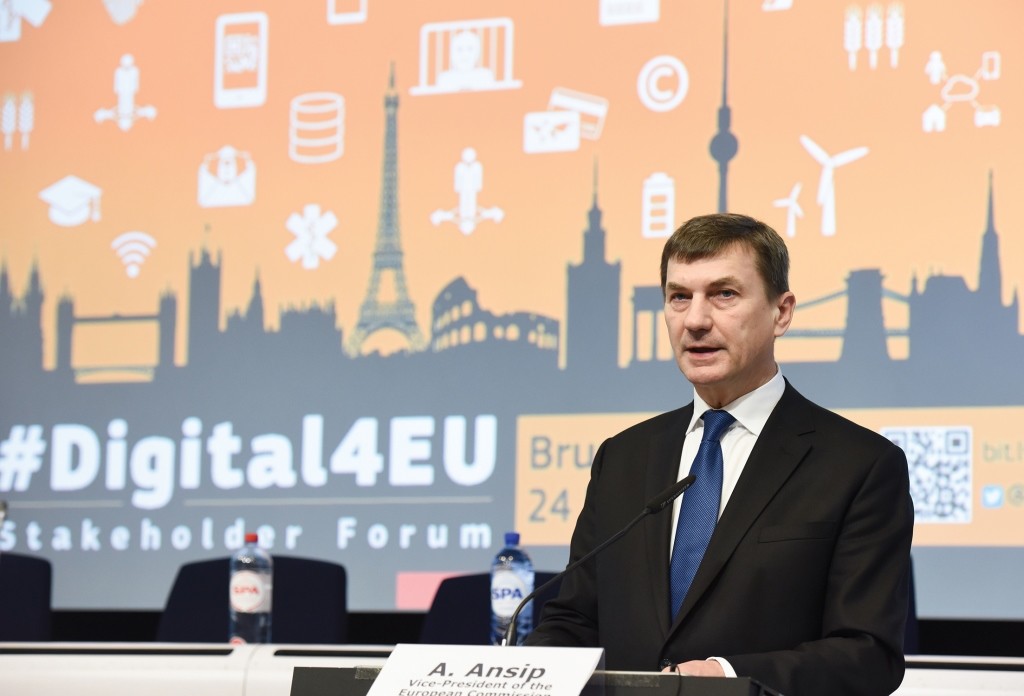My aim is to make sure that Europe, its citizens and businesses, get the best of the online world in the safest and most open environment possible. Openness and opportunity: not obstacles.
By Andrus Ansip, VP of the European Commission for the digital single market. Published in collaboration with Life in Estonia magazine.
I
Estonia is no stranger to the digital world. As long ago as 2005, it became the first country to hold an election where people could vote online. I was one of the first people to try out the new system. Now, in 2015, the number of Estonians to cast an e-vote in parliamentary elections rose to a record number – 31% of those who voted.
I am immensely proud to have been at the forefront of the digital transformation of my country, which today has probably the most joined-up digital government anywhere. Estonia has managed to create a true e-society that has improved peoples’ lives in many different ways.
Take digital signatures, where we have more than a decade of experience. They allow people to vote electronically, do their banking, declare taxes, sign contracts – all without leaving either home or the office.
When Estonians started to use digital signatures, it was like a social and commercial explosion. Since the system became available, more than 100 million digital signatures have been made in Estonia.
I would like to see digital signatures mutually recognised across the EU’s 28 countries.
Every Estonian citizen now has an ID card, which contains biometric information about them as well as digital signing capabilities. Again, I was one of the first people to start using these.
That said, I don’t always want to point to my own country as a shining example. However, what is now normal for Estonians in their daily lives is not yet the same for people in much of the rest of Europe.
During my nine years as prime minister, I supported the goal of creating a digital single market for the European Union that really works. Digital issues are close to my heart, which is why I was pleased to be nominated as vice president for the digital single market at the European Commission in Brussels.
Digital activity is everywhere. Every economic pursuit, every sector of society uses digital tools and online networks. With the power of cloud computing, the growing reach of social networking, the rise of big data, all manner of mobile devices available, technology is developing at lightning speed.
Europeans want the best that the internet can offer; they want safe, accessible and fast online services; they want more choice and competitive prices that the world’s largest marketplace should be able to provide. They want to be able to enjoy online films, music, books ̶ bought anywhere in the EU. No price discrimination, website blocking or re-routing because of where they happen to live.
Unjustified geo-blocking is unfortunately still a reality, with messages like, “This service is not available in your country” that can appear on screen. For me, this is a form of discrimination – and something we fought hard to remove in the physical world. People do not understand why they cannot access content they have paid for when they travel abroad. In the same way, they cannot understand why they cannot access content they are willing to pay for in the first place. This should all be possible in the 21st century, the digital age. But it is not yet a reality across Europe.
There is still a lot of work to do to achieve a truly connected digital single market. A market where every consumer can enjoy digital content and services – wherever they are in Europe, including government services. It means every company should be able to share and sell its wares online to a market of 500 million consumers, with ease.
Today, a small business trying to spread across the EU faces no less than 28 regulations concerning consumer protection, data protection, contract law and tax rates. People trying to buy online in Europe today face endless barriers. It also costs too much, both for consumers and businesses.
Take the cost of getting delivery of a parcel of goods that you have bought online, but from a retail website based in another EU country. The charge for delivering across an EU border can be five times – even more, sometimes ̶ the national equivalent.
We are working hard to remove the obstacles to create a connected digital single market for Europe.
Bringing down barriers is what Europe is about, to give all Europeans more opportunities so that they can enjoy competition, convenience and choice online.
At the same time, we have to set about building, improving and connecting digital Europe.
Building trust and confidence, for example, so that people are confident about using the Internet and online services. Or improving areas like technical interoperability and standards across the EU, which will also help to improve access to networks between countries.
Connecting everyone, everywhere, by investing in modern and joined-up broadband infrastructure, so that people in the remotest areas can also enjoy high-speed internet access. Fast, reliable, secure connectivity – everywhere.
These main principles will form the basis of a long-term digital strategy that the European Commission will present in May. It will contain proposals for new legislation and the updating of existing laws so that we have better regulation – rules that are “fit for purpose” – in the digital age.
For people, the digital single market will be a digital space where users’ electronic data can easily be carried or transferred across platforms and systems in all EU countries, without discrimination based on nationality or unjustified geo-blocking.
For businesses, it will allow them to reach new EU markets easily, backed by a clear set of rules. Companies, particularly small and/or online businesses, should be able to start operating across the EU with just one click of the mouse, without burdens or restrictions. This will allow them to grow, scale up quickly and transform their business and industrial models to include digital technologies.
This means moving further on consumer rights, and simplifying and modernising rules for online purchases and digital products, for both buyers and sellers. It will mean concluding negotiations on data protection and cyber-security. It will also involve reforming and modernising EU copyright rules.
We have a great opportunity and should make the best of it. My aim is to make sure that Europe, its citizens and businesses, get the best of the online world in the safest and most open environment possible. Openness and opportunity: not obstacles.
I
Andrus Ansip
Andrus Ansip was appointed vice president of the European Commission with responsibility for the digital single market in November 2014. Before moving to Brussels, he was a member of both the Estonian and European Parliaments. This followed almost nine years in Tallinn spent as Estonia’s longest-serving prime minister, when Ansip worked with both centre-right and centre-left parties to lead three different coalition governments. During his time as prime minister, he also acted as chairman of Estonia’s Reform Party.
Ansip first entered national politics in September 2004 when he became minister of the economy. Up to this point, his career was spent in Estonia’s second largest city of Tartu where he was born in 1956.
Ansip was mayor of Tartu for six years after working in banking and business. A chemistry graduate from the city’s university, Ansip is married with three children.
I
Cover photo by Kaupo Kikkas.
BROUGHT TO YOU BY
I



